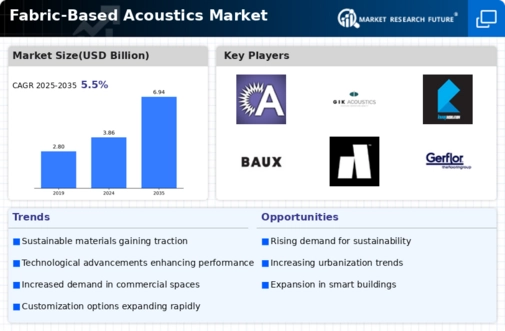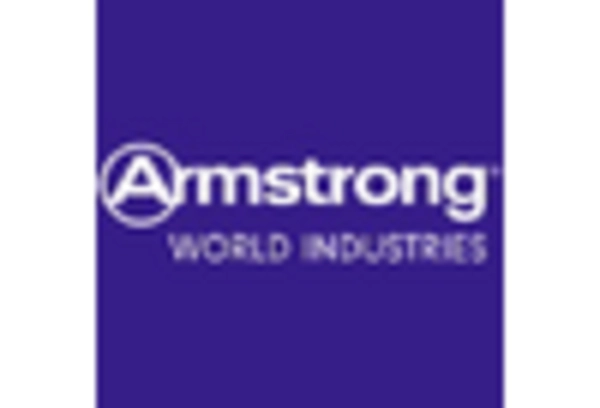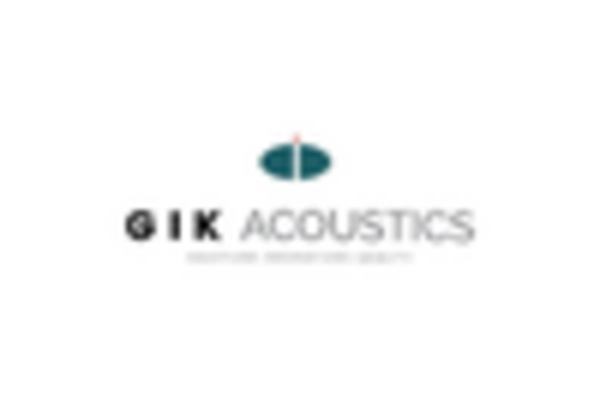Integration of Smart Technologies
The advent of smart technologies in building design and construction is influencing the Fabric-Based Acoustics Market. The integration of Internet of Things (IoT) devices and smart sensors into acoustic solutions allows for real-time monitoring and adjustment of sound levels in various environments. This trend suggests a shift towards more adaptive and responsive acoustic solutions, which could enhance user comfort and satisfaction. As smart buildings become more prevalent, the demand for fabric-based acoustic materials that can seamlessly integrate with these technologies is expected to rise. Market analysts indicate that the smart building sector is anticipated to witness substantial growth, potentially reaching a valuation of over 500 billion dollars by 2026, thereby providing a lucrative opportunity for fabric-based acoustic manufacturers.
Customization and Aesthetic Appeal
The desire for personalized and aesthetically pleasing environments is shaping the Fabric-Based Acoustics Market. Consumers and businesses alike are increasingly seeking acoustic solutions that not only perform well but also enhance the visual appeal of their spaces. This trend indicates a growing market for customizable fabric-based acoustic products that can be tailored to specific design requirements. Manufacturers are responding by offering a diverse range of colors, patterns, and textures, allowing for greater integration into various interior styles. As the market for interior design continues to evolve, the demand for fabric-based acoustics that combine functionality with aesthetic value is expected to rise, potentially leading to increased sales and market penetration.
Focus on Sustainable Building Practices
The growing emphasis on sustainability in construction and interior design is significantly impacting the Fabric-Based Acoustics Market. As more architects and builders prioritize eco-friendly materials, the demand for sustainable acoustic solutions is likely to increase. Fabric-based acoustics, often made from recycled or renewable materials, align well with these sustainable practices. Recent data indicates that the green building materials market is expected to expand at a rate of around 10% annually, reflecting a broader trend towards environmentally responsible construction. This shift not only enhances the appeal of fabric-based acoustic products but also positions them as essential components in sustainable building projects, thereby driving market growth.
Regulatory Support for Acoustic Standards
The establishment of regulatory frameworks and standards for acoustic performance in buildings is likely to bolster the Fabric-Based Acoustics Market. Governments and regulatory bodies are increasingly recognizing the importance of sound control in enhancing quality of life and productivity. This recognition has led to the implementation of stricter acoustic regulations in various sectors, including education, healthcare, and hospitality. As compliance with these standards becomes mandatory, the demand for effective acoustic solutions, particularly fabric-based options, is expected to grow. Market projections suggest that the implementation of these regulations could result in a significant uptick in the adoption of fabric-based acoustics, as stakeholders seek to meet the required performance benchmarks.
Rising Demand for Noise Control Solutions
The increasing awareness of noise pollution and its adverse effects on health and productivity appears to drive the Fabric-Based Acoustics Market. As urbanization accelerates, the need for effective noise control solutions in residential, commercial, and industrial settings becomes more pronounced. According to recent estimates, the market for acoustic materials is projected to grow at a compound annual growth rate of approximately 7% over the next five years. This growth is likely fueled by the rising demand for soundproofing solutions in open office spaces and public venues, where noise reduction is essential for enhancing user experience. Consequently, manufacturers are focusing on developing innovative fabric-based acoustic solutions that not only mitigate sound but also contribute to aesthetic appeal, thereby expanding their market reach.


















Leave a Comment